Enhancement of Bonding and Mechanical Performance of Epoxy Asphalt Bond Coats with Graphene Nanoplatelets
Abstract
:1. Introduction
2. Materials and Methods
2.1. Materials
2.2. Preparation of GNP-Reinforced EABCs
2.3. Methods
2.3.1. Viscosity–Time Behavior
2.3.2. Phase-Separated Microstructures
2.3.3. Hydrophobicity
2.3.4. Dynamic Mechanical Analysis (DMA)
2.3.5. Mechanical Performance
2.3.6. Shear Strength
2.3.7. Pull-Off Adhesion Strength
3. Results and Discussion
3.1. Phase Separation
3.2. Rotational Viscosity
3.3. Hydrophobicity
3.4. Viscoelasticity
3.4.1. Storage Modulus (E′)
3.4.2. Loss Modulus (E″)
3.4.3. Loss Factor
3.4.4. Cole–Cole Plot
3.5. Mechanical Performance
3.6. Bonding Properties
3.6.1. Single-Lap Shear Strength
3.6.2. Pull-Off Adhesion Strength
4. Conclusions
Author Contributions
Funding
Institutional Review Board Statement
Data Availability Statement
Conflicts of Interest
References
- Hu, K.; Kulkarni, D.D.; Choi, I.; Tsukruk, V.V. Graphene-polymer nanocomposites for structural and functional applications. Prog. Polym. Sci. 2014, 39, 1934–1972. [Google Scholar] [CrossRef]
- Geim, A.K. Graphene: Status and prospects. Science 2009, 324, 1530–1534. [Google Scholar] [CrossRef] [PubMed] [Green Version]
- Tiwari, S.K.; Sahoo, S.; Wang, N.; Huczko, A. Graphene research and their outputs: Status and prospect. J. Sci. Adv. Mater. Devices 2020, 5, 10–29. [Google Scholar] [CrossRef]
- Shi, G.; Araby, S.; Gibson, C.T.; Meng, Q.; Zhu, S.; Ma, J. Graphene platelets and their polymer composites: Fabrication, structure, properties, and applications. Adv. Funct. Mater. 2018, 28, 1706705. [Google Scholar] [CrossRef]
- Zhao, R.; Jing, F.; Li, C.; Wang, R.; Xi, Z.; Cai, J.; Wang, Q.; Xie, H. Viscosity-curing time behavior, viscoelastic properties, and phase separation of graphene oxide/epoxy asphalt composites. Polym. Compos. 2022, 43, 5454–5464. [Google Scholar] [CrossRef]
- Botta, L.; Scaffaro, R.; Sutera, F.; Mistretta, M.C. Reprocessing of PLA/graphene nanoplatelets nanocomposites. Polymers 2018, 10, 18. [Google Scholar] [CrossRef] [Green Version]
- Gaska, K.; Xu, X.; Gubanski, S.; Kádár, R. Electrical, mechanical, and thermal properties of ldpe graphene nanoplatelets composites produced by means of melt extrusion process. Polymers 2017, 9, 11. [Google Scholar] [CrossRef] [Green Version]
- Mostovoy, A.; Shcherbakov, A.; Yakovlev, A.; Arzamastsev, S.; Lopukhova, M. Reinforced epoxy composites modified with functionalized graphene oxide. Polymers 2022, 14, 338. [Google Scholar] [CrossRef]
- Le, M.-T.; Huang, S.-C. Thermal and mechanical behavior of hybrid polymer nanocomposite reinforced with graphene nanoplatelets. Materials 2015, 8, 5526–5536. [Google Scholar] [CrossRef] [Green Version]
- Palomba, M.; Carotenuto, G.; Longo, A.; Sorrentino, A.; Di Bartolomeo, A.; Iemmo, L.; Urban, F.; Giubileo, F.; Barucca, G.; Rovere, M.; et al. Thermoresistive properties of graphite platelet films supported by different substrates. Materials 2019, 12, 3638. [Google Scholar] [CrossRef]
- King, J.A.; Klimek, D.R.; Miskioglu, I.; Odegard, G.M. Mechanical properties of graphene nanoplatelet/epoxy composites. J. Appl. Polym. Sci. 2013, 128, 4217–4223. [Google Scholar] [CrossRef]
- Panta, J.; Zhang, Y.X.; Rider, A.N.; Wang, J. Ozone functionalized graphene nanoplatelets and triblock copolymer hybrids as nanoscale modifiers to enhance the mechanical performance of epoxy adhesives. Int. J. Adhes. Adhes. 2022, 116, 103135. [Google Scholar] [CrossRef]
- Zhang, G.; Wang, F.; Dai, J.; Huang, Z. Effect of functionalization of graphene nanoplatelets on the mechanical and thermal properties of silicone rubber composites. Materials 2016, 9, 92. [Google Scholar] [CrossRef] [PubMed] [Green Version]
- Cataldi, P.; Athanassiou, A.; Bayer, I.S. Graphene nanoplatelets-based advanced materials and recent progress in sustainable applications. Appl. Sci. 2018, 8, 1438. [Google Scholar] [CrossRef] [Green Version]
- Gorrasi, G.; Bugatti, V.; Milone, C.; Mastronardo, E.; Piperopoulos, E.; Iemmo, L.; Di Bartolomeo, A. Effect of temperature and morphology on the electrical properties of PET/conductive nanofillers composites. Compos. Part B 2018, 135, 149–154. [Google Scholar] [CrossRef]
- Chieng, B.W.; Ibrahim, N.A.; Yunus, W.M.Z.W.; Hussein, M.Z. Poly(lactic acid)/poly(ethylene glycol) polymer nanocomposites: Effects of graphene nanoplatelets. Polymers 2014, 6, 93–104. [Google Scholar] [CrossRef] [Green Version]
- Pereira, P.; Ferreira, D.P.; Araújo, J.C.; Ferreira, A.; Fangueiro, R. The potential of graphene nanoplatelets in the development of smart and multifunctional ecocomposites. Polymers 2020, 12, 2189. [Google Scholar] [CrossRef] [PubMed]
- Marra, F.; D’Aloia, A.G.; Tamburrano, A.; Ochando, I.M.; De Bellis, G.; Ellis, G.; Sarto, M.S. Electromagnetic and dynamic mechanical properties of epoxy and vinylester-based composites filled with graphene nanoplatelets. Polymers 2016, 8, 272. [Google Scholar] [CrossRef] [PubMed] [Green Version]
- Ali, I.; Kim, N.K.; Bhattacharyya, D. Effects of graphene nanoplatelets on mechanical and fire performance of flax polypropylene composites with intumescent flame retardant. Molecules 2021, 26, 4094. [Google Scholar] [CrossRef] [PubMed]
- Mangus, A. Orthotropic steel decks. In Bridge Engineering Handbook: Superstructure Design, 2nd ed.; Chen, W.-F., Duan, L., Eds.; CRC Press: Boca Raton, FL, USA, 2014; pp. 589–646. [Google Scholar]
- Bocci, E.; Canestrari, F. Analysis of structural compatibility at interface between asphalt concrete pavements and orthotropic steel deck surfaces. Transp. Res. Rec. 2012, 2293, 1–7. [Google Scholar] [CrossRef]
- Huang, Q.; Qian, Z.; Chen, L.; Zhang, M.; Zhang, X.; Sun, J.; Hu, J. Evaluation of epoxy asphalt rubber with silane coupling agent used as tack coat for seasonally frozen orthotropic steel bridge decks. Constr. Build. Mater. 2020, 241, 117957. [Google Scholar] [CrossRef]
- Cuadri, A.A.; Delgado-Sánchez, C.; Navarro, F.J.; Partal, P. Short- and long-term epoxy modification of bitumen: Modification kinetics, rheological properties, and microstructure. Polymers 2020, 12, 508. [Google Scholar] [CrossRef] [PubMed] [Green Version]
- Luo, S.; Sun, J.; Hu, J.; Liu, S. Performance evolution mechanism of hot-mix epoxy asphalt binder and mixture based on component characteristics. J. Mater. Civ. Eng. 2022, 34, 04022235. [Google Scholar] [CrossRef]
- Simpson, W.C.; Sommer, H.J.; Griffin, R.L.; Miles, T.K. Epoxy asphalt concrete for airfield pavements. J. Air Transp. Div. 1960, 86, 57–71. [Google Scholar] [CrossRef]
- Li, M.; Min, Z.; Wang, Q.; Huang, W.; Shi, Z. Influence of curing agent ratio, asphalt content and crosslinking degree on the compatibility and component distribution of epoxy asphalt in compound curing agent system. Int. J. Pavement Eng. 2022. [Google Scholar] [CrossRef]
- Kang, Y.; Jin, R.; Wu, Q.; Pu, L.; Song, M.; Cheng, J.; Yu, P. Anhydrides-cured bimodal rubber-like epoxy asphalt composites: From thermosetting to quasi-thermosetting. Polymers 2016, 8, 104. [Google Scholar] [CrossRef] [PubMed] [Green Version]
- Sun, J.; Huang, W.; Lu, G.; Luo, S.; Li, Y. Investigation of the performance and micro-evolution mechanism of low-content thermosetting epoxy asphalt binder towards sustainable highway and bridge decks paving. J. Clean. Prod. 2023, 384, 135588. [Google Scholar] [CrossRef]
- Wang, C.; Wu, Q.; Liu, Y.; Zhang, M.; Zhang, Z.; Zhou, D.; Kang, Y. Mechanical properties of tri-modal epoxy asphalt composites. Int. J. Pavement Eng. 2022, 23, 5118–5126. [Google Scholar] [CrossRef]
- Xie, H.; Li, C.; Wang, Q. A critical review on performance and phase separation of thermosetting epoxy asphalt binders and bond coats. Constr. Build. Mater. 2022, 326, 126792. [Google Scholar] [CrossRef]
- Pipintakos, G.; Hasheminejad, N.; Lommaert, C.; Bocharova, A.; Blom, J. Application of Atomic Force (AFM), Environmental Scanning Electron (ESEM) and Confocal Laser Scanning Microscopy (CLSM) in bitumen: A review of the ageing effect. Micron 2021, 147, 103083. [Google Scholar] [CrossRef]
- Zhang, Z.; Sun, J.; Huang, Z.; Wang, F.; Jia, M.; Lv, W.; Ye, J. A laboratory study of epoxy/polyurethane modified asphalt binders and mixtures suitable for flexible bridge deck pavement. Constr. Build. Mater. 2021, 274, 122084. [Google Scholar] [CrossRef]
- Liu, Q.; Wang, C.; Zhang, Z.; Du, C.; Liu, P.; Oeser, M. Influence of preparation methods on the performance of cold-mixed epoxy bitumen. Mater. Struct. 2021, 54, 74. [Google Scholar] [CrossRef]
- Liu, Y.; Qian, Z.; Wang, Y.; Xue, Y. Development and laboratory evaluation of a cold mix high-early-strength epoxy asphalt concrete for steel bridge deck pavements. Materials 2021, 14, 4555. [Google Scholar] [CrossRef] [PubMed]
- Zhang, J.; Wang, R.; Zhao, R.; Jing, F.; Li, C.; Wang, Q.; Xie, H. Graphene oxide-modified epoxy asphalt bond coats with enhanced bonding properties. Materials 2022, 15, 6846. [Google Scholar] [CrossRef]
- Si, J.; Wang, J.; Li, Y.; Ma, J.; Ruan, W.; Yu, X.; Jiang, R. Enhanced mechanical performances of epoxy asphalt adhesives modified by graphene oxide. Road Mater. Pavement Des. 2022. [Google Scholar] [CrossRef]
- Anwar, Z.; Kausar, A.; Rafique, I.; Muhammad, B. Advances in epoxy/graphene nanoplatelet composite with enhanced physical properties: A review. Polym.-Plast. Technol. Eng. 2016, 55, 643–662. [Google Scholar] [CrossRef]
- Kausar, A.; Anwar, Z.; Muhammad, B. Recent developments in epoxy/graphite, epoxy/graphene, and epoxy/graphene nanoplatelet composites: A comparative review. Polym.-Plast. Technol. Eng. 2016, 55, 1192–1210. [Google Scholar] [CrossRef]
- Moretti, L.; Fabrizi, N.; Fiore, N.; D’Andrea, A. Mechanical characteristics of graphene nanoplatelets-modified asphalt mixes: A comparison with polymer- and not-modified asphalt mixes. Materials 2021, 14, 2434. [Google Scholar] [CrossRef]
- Han, M.; Muhammad, Y.; Wei, Y.; Zhu, Z.; Huang, J.; Li, J. A review on the development and application of graphene based materials for the fabrication of modified asphalt and cement. Constr. Build. Mater. 2021, 285, 122885. [Google Scholar] [CrossRef]
- Zhang, F.; Liu, X.; Zhang, L.; Zhou, S.; Huang, K. Preparation and properties of epoxy asphalt modified by biomimetic graphene oxide nanocomposites. J. Mater. Civ. Eng. 2023, 35, 04022392. [Google Scholar] [CrossRef]
- Zhang, L.; Zhang, F.; Huang, K.; Zhou, S.; Guo, Y. Preparation and performance of graphene nanoplatelets-modified epoxy asphalt. J. Perform. Constr. Facil. 2021, 35, 04021083. [Google Scholar] [CrossRef]
- Zhao, R.; Jing, F.; Li, C.; Wang, R.; Xi, Z.; Cai, J.; Wang, Q.; Xie, H. Phase-separated microstructures and viscosity-time behavior of graphene nanoplatelet modified warm-mix epoxy asphalt binders. Mater. Struct. 2022, 55, 248. [Google Scholar] [CrossRef]
- Gong, J.; Jing, F.; Zhao, R.; Li, C.; Cai, J.; Wang, Q.; Xie, H. Waste cooking oil-modified epoxy asphalt rubber binders with improved compatibility and extended allowable construction time. Molecules 2022, 27, 7061. [Google Scholar] [CrossRef]
- Zhao, R.; Jing, F.; Wang, R.; Cai, J.; Zhang, J.; Wang, Q.; Xie, H. Influence of oligomer content on viscosity and dynamic mechanical properties of epoxy asphalt binders. Constr. Build. Mater. 2022, 338, 127524. [Google Scholar] [CrossRef]
- Fan, Y.H.; Yu, S.W.; Wang, H.M.; Yao, Y.H.; Wang, Y.; Wang, C.H. Study on preparation and properties of graphene reinforced epoxy resin composites. IOP Conf. Ser. Mater. Sci. Eng. 2019, 634, 012044. [Google Scholar] [CrossRef]
- Sun, Y.; Han, X.; Su, W.; Gong, J.; Xi, Z.; Zhang, J.; Wang, Q.; Xie, H. Mechanical and bonding properties of pristine montmorillonite reinforced epoxy asphalt bond coats. Polym. Compos. 2020, 41, 3034–3042. [Google Scholar] [CrossRef]
- Sun, Y.; Liu, Y.; Jiang, Y.; Xu, K.; Xi, Z.; Xie, H. Thermal and mechanical properties of natural fibrous nanoclay reinforced epoxy asphalt adhesives. Int. J. Adhes. Adhes. 2018, 85, 308–314. [Google Scholar] [CrossRef]
- Zhang, M.; Ma, Y.; Zhu, Y.; Che, J.; Xiao, Y. Two-dimensional transparent hydrophobic coating based on liquid-phase exfoliated graphene fluoride. Carbon 2013, 63, 149–156. [Google Scholar] [CrossRef]
- Li, G.; Lee-Sullivan, P.; Thring, R.W. Determination of activation energy for glass transition of an epoxy adhesive using dynamic mechanical analysis. J. Therm. Anal. Calorim. 2000, 60, 377–390. [Google Scholar] [CrossRef]
- Sun, Y.; Liu, Y.; Gong, J.; Han, X.; Xi, Z.; Zhang, J.; Wang, Q.; Xie, H. Thermal and bonding properties of epoxy asphalt bond coats. J. Therm. Anal. Calorim. 2022, 147, 2013–2025. [Google Scholar] [CrossRef]
- Turner, T.F.; Branthaver, J.F. DSC studies of asphalts and asphalt components. In Asphalt Science and Technology; Usmani, A., Ed.; CRC Press: New York, NY, USA, 1997; pp. 59–101. [Google Scholar]
- Devi, L.U.; Bhagawan, S.S.; Thomas, S. Dynamic mechanical analysis of pineapple leaf/glass hybrid fiber reinforced polyester composites. Polym. Compos. 2010, 31, 956–965. [Google Scholar] [CrossRef]
- Saba, N.; Paridah, M.T.; Abdan, K.; Ibrahim, N.A. Dynamic mechanical properties of oil palm nano filler/kenaf/epoxy hybrid nanocomposites. Constr. Build. Mater. 2016, 124, 133–138. [Google Scholar] [CrossRef]
- Klimek-McDonald, D.R.; King, J.A.; Miskioglu, I.; Pineda, E.J.; Odegard, G.M. Determination and modeling of mechanical properties for graphene nanoplatelet/epoxy composites. Polym. Compos. 2018, 39, 1845–1851. [Google Scholar] [CrossRef]
- Han, M.; Li, J.; Muhammad, Y.; Hou, D.; Zhang, F.; Yin, Y.; Duan, S. Effect of polystyrene grafted graphene nanoplatelets on the physical and chemical properties of asphalt binder. Constr. Build. Mater. 2018, 174, 108–119. [Google Scholar] [CrossRef]
- Brostow, W.; Hagg Lobland, H.E.; Khoja, S. Brittleness and toughness of polymers and other materials. Mater. Lett. 2015, 159, 478–480. [Google Scholar] [CrossRef]
- Jing, F.; Zhao, R.; Li, C.; Xi, Z.; Wang, Q.; Xie, H. Influence of the epoxy/acid stoichiometry on the cure behavior and mechanical properties of epoxy vitrimers. Molecules 2022, 27, 6335. [Google Scholar] [CrossRef] [PubMed]
- Brostow, W.; Hagg Lobland, H.E.; Narkis, M. Sliding wear, viscoelasticity, and brittleness of polymers. J. Mater. Res. 2006, 21, 2422–2428. [Google Scholar] [CrossRef] [Green Version]
- Kagalkar, N.; Srinivas, S.; Dhananjaya, B.R. Determination of shear strength and failure type of the sealant using lap shear test. Mater. Today Proc. 2018, 5, 2752–2758. [Google Scholar] [CrossRef]
- Shim, G.H.; Kweon, B.; Lee, M.S.; Kim, J.H.; Jun, T.S.; Kim, T.; Jerng, D.-W.; Mahian, O.; Wongwises, S.; Ahn, H.S. Highly improved mechanical and thermal properties of alkali silicate and graphene nanoplatelet composite adhesives. Int. J. Adhes. Adhes. 2021, 110, 102942. [Google Scholar] [CrossRef]

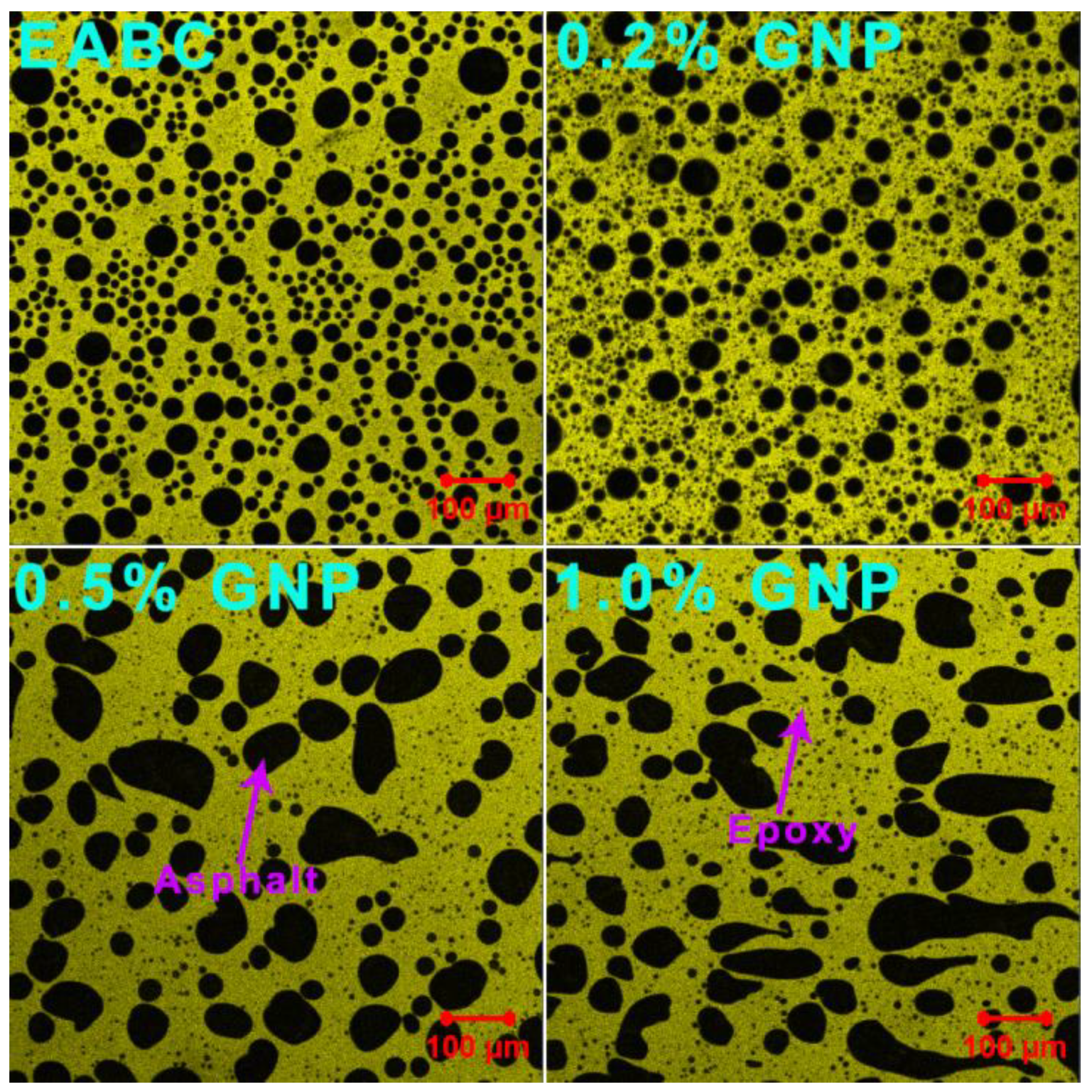


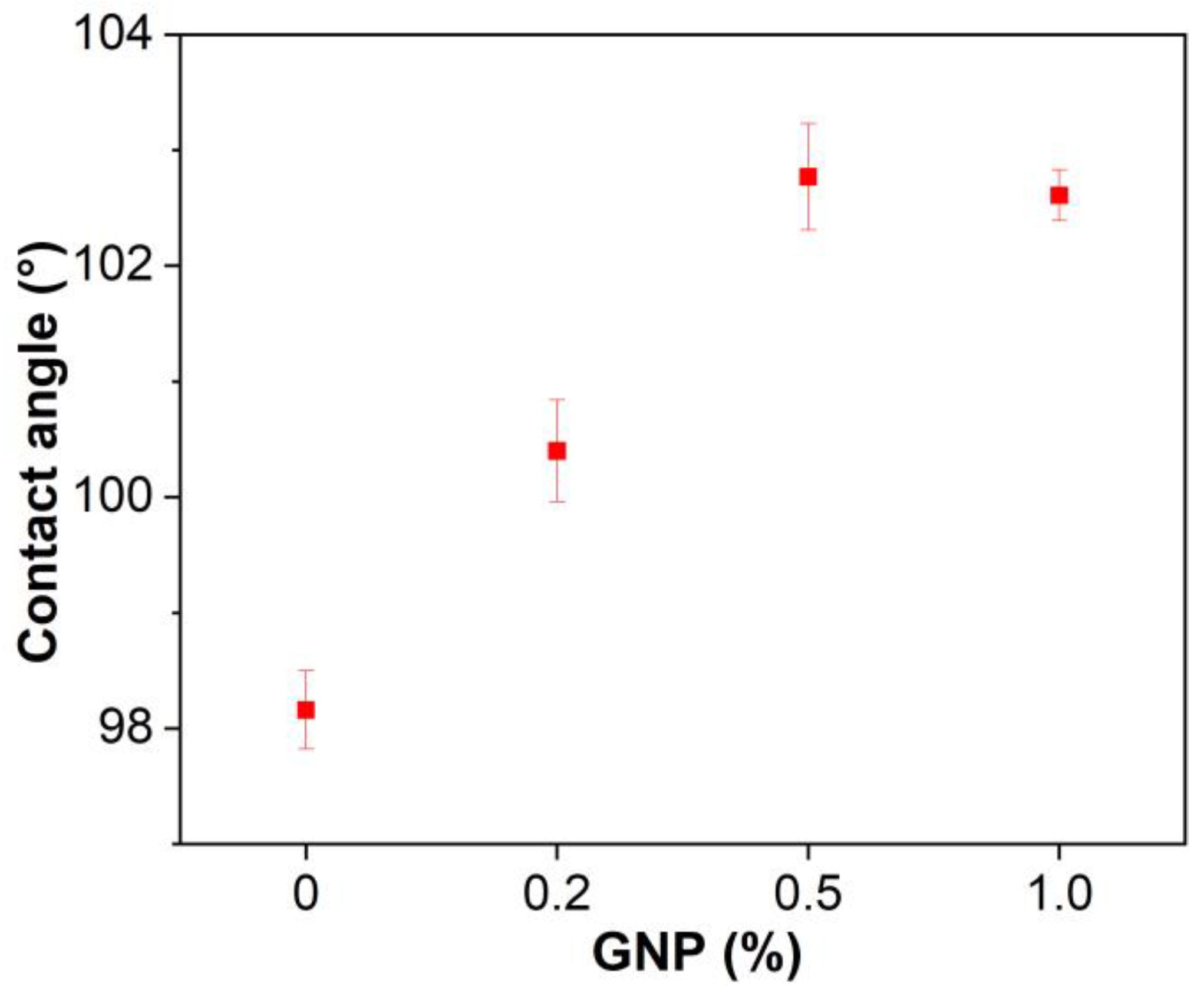

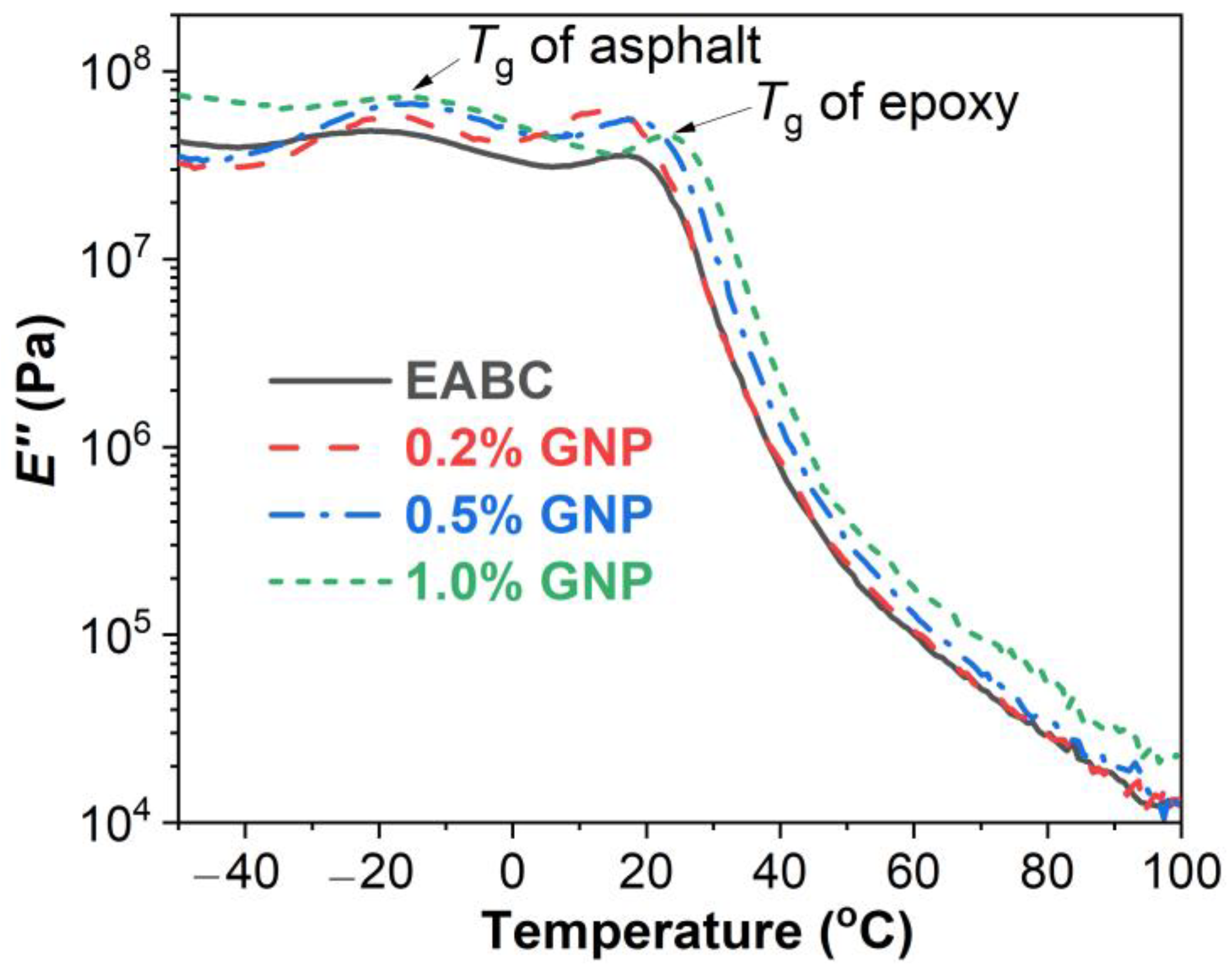
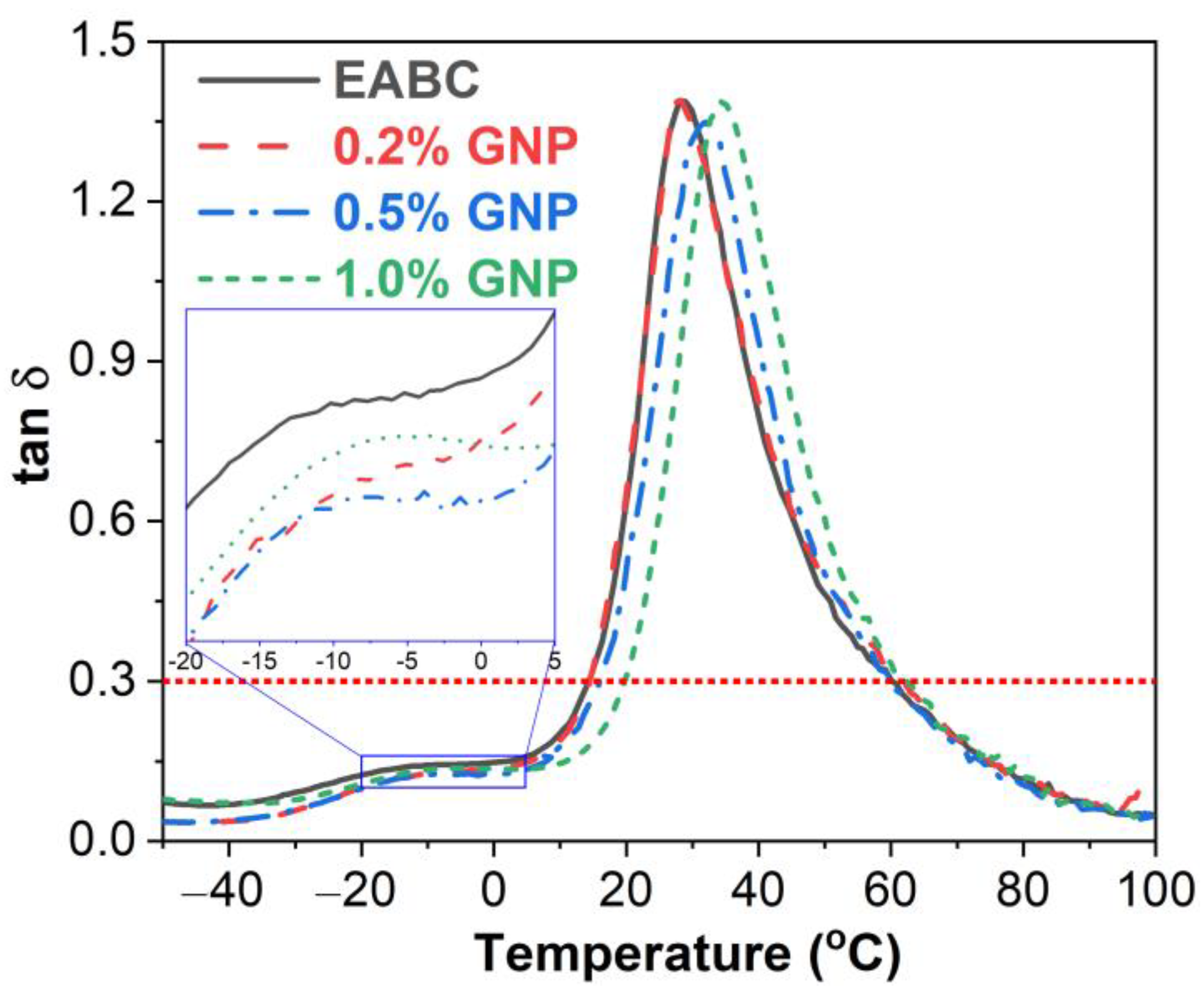
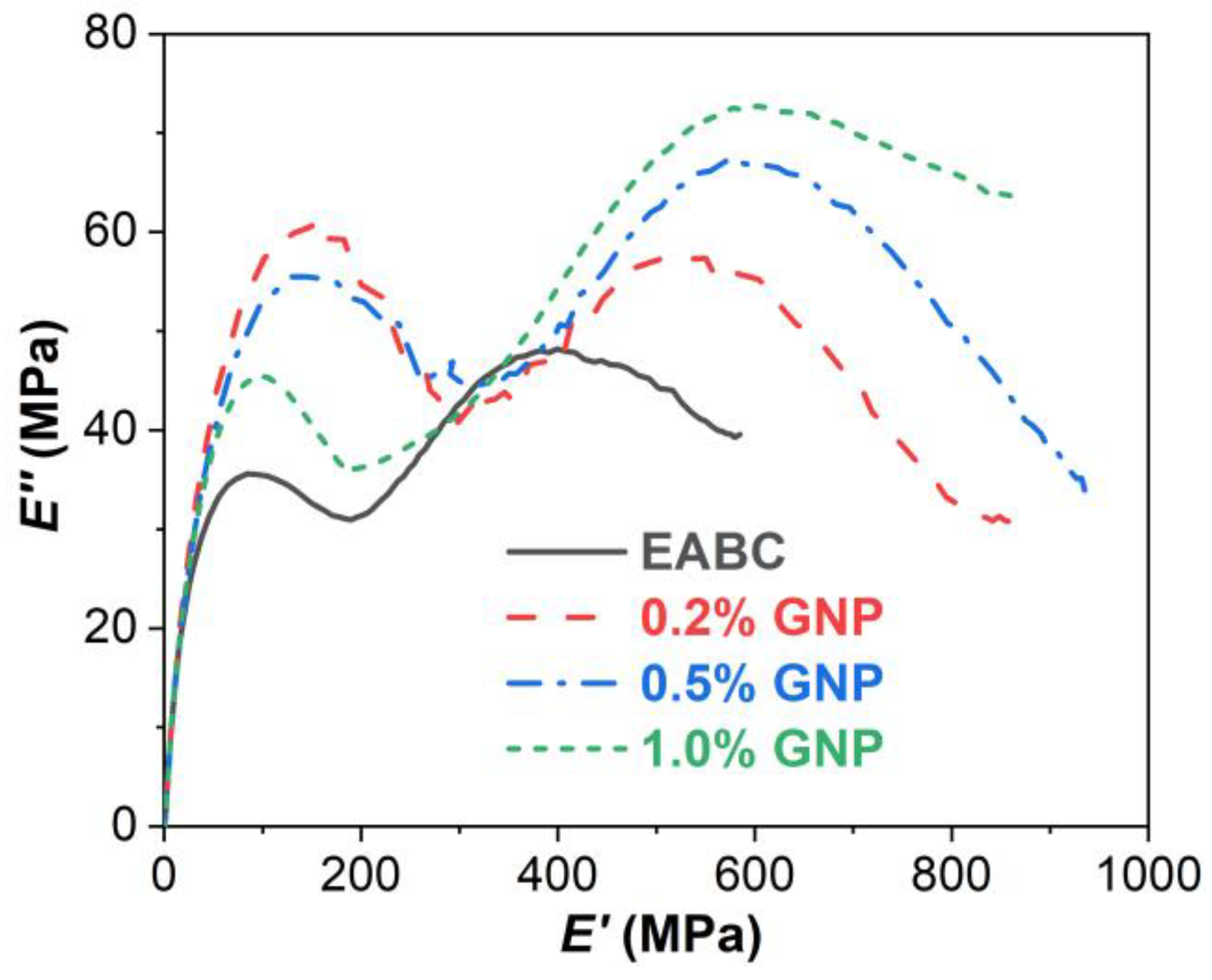


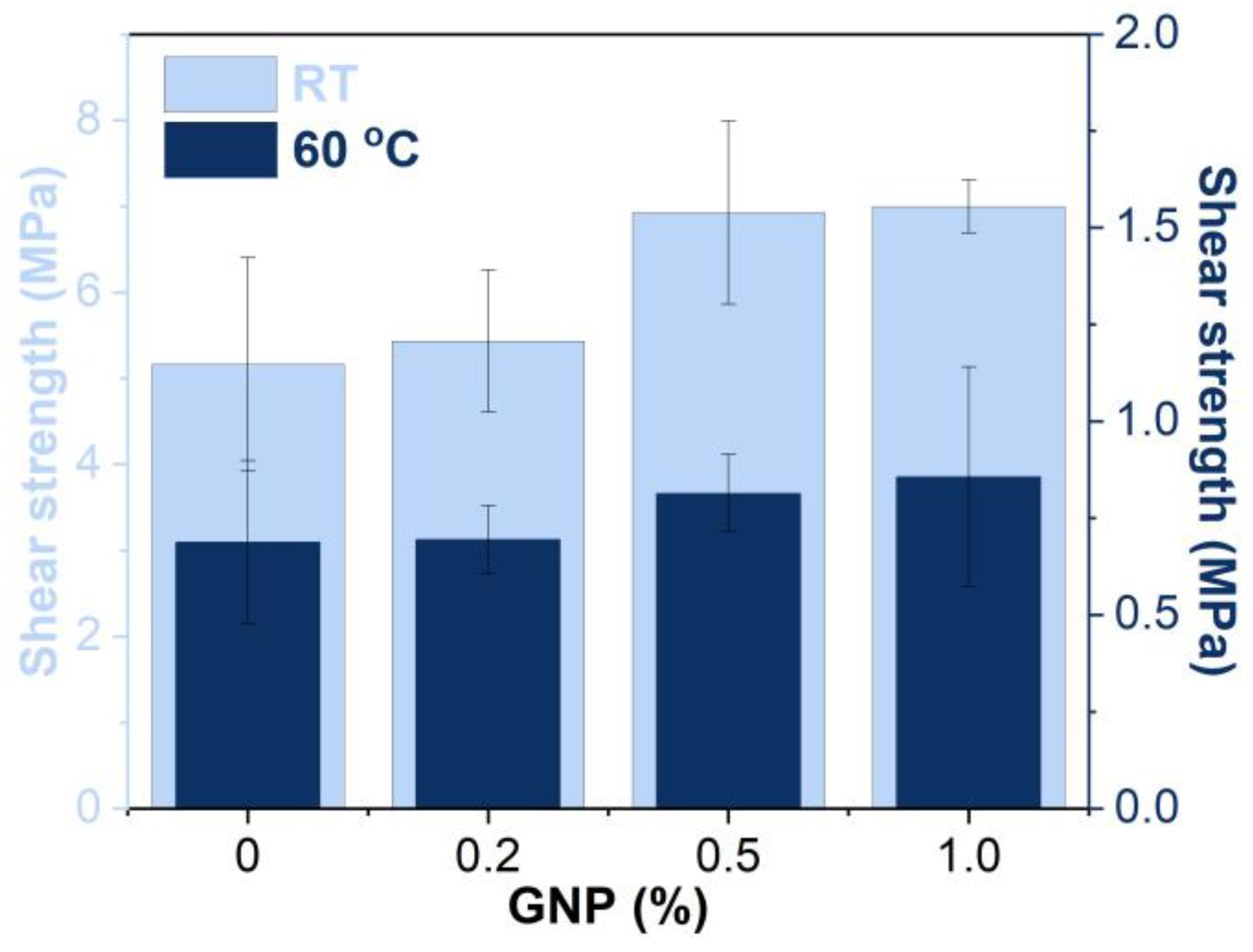


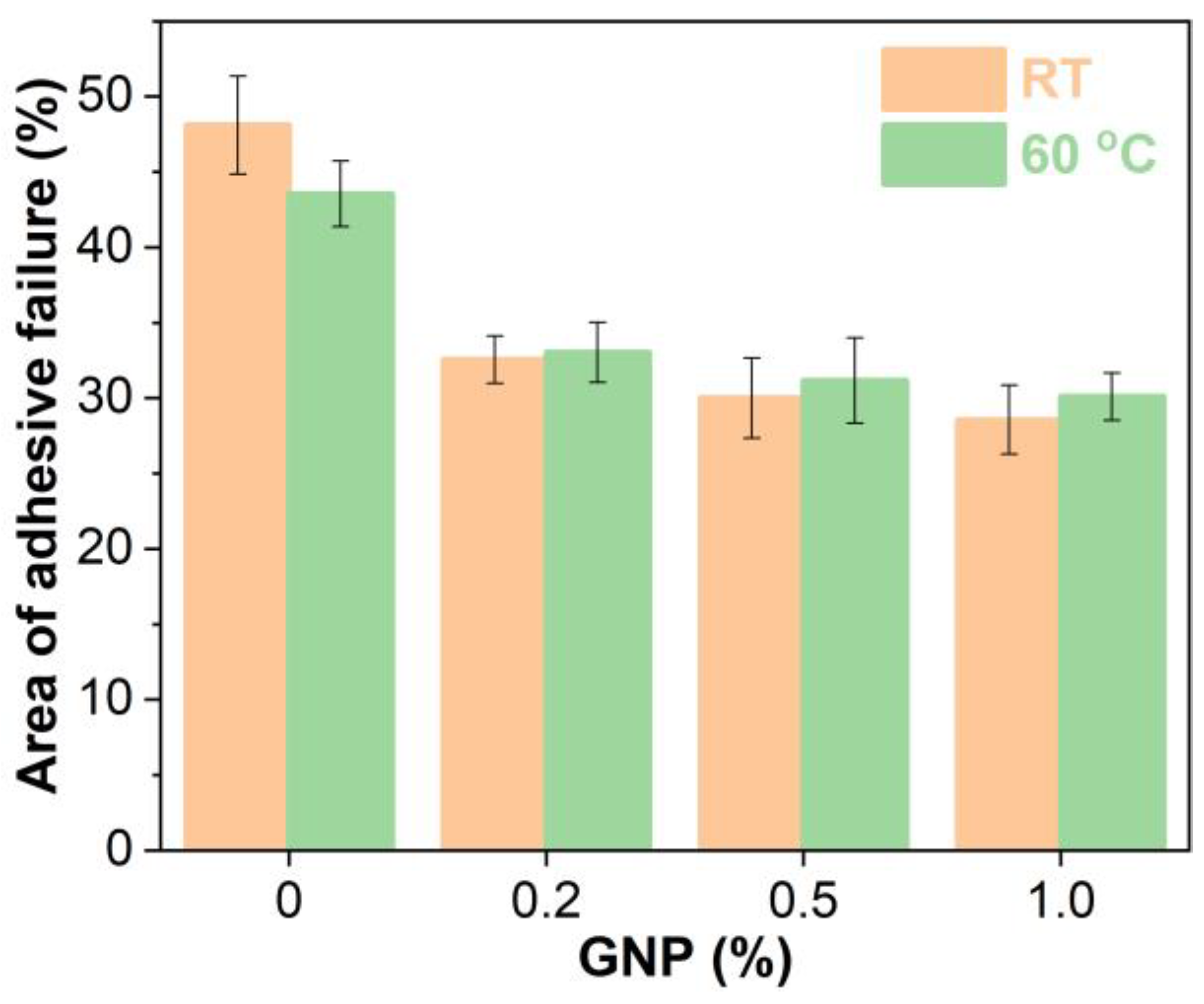
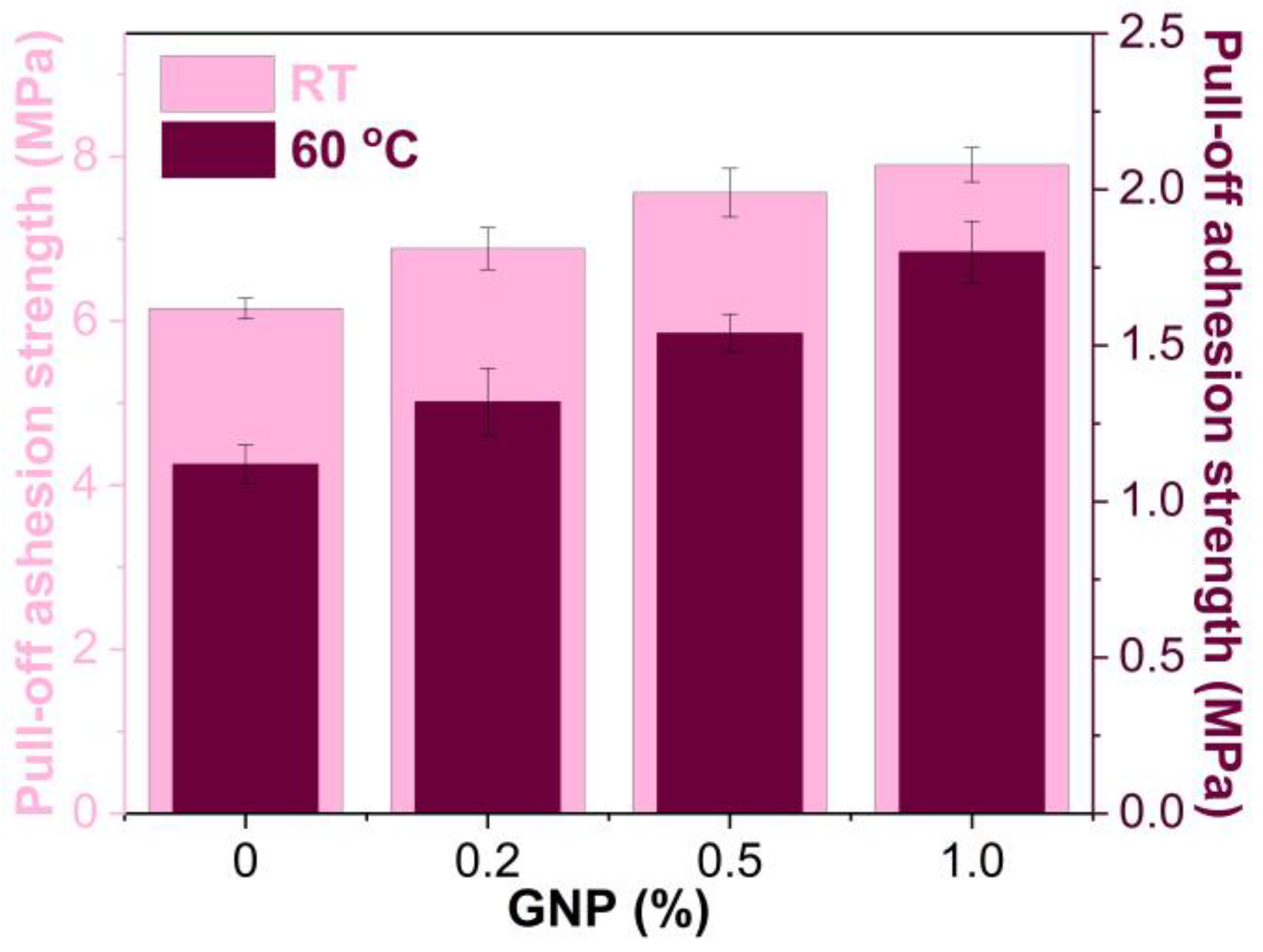
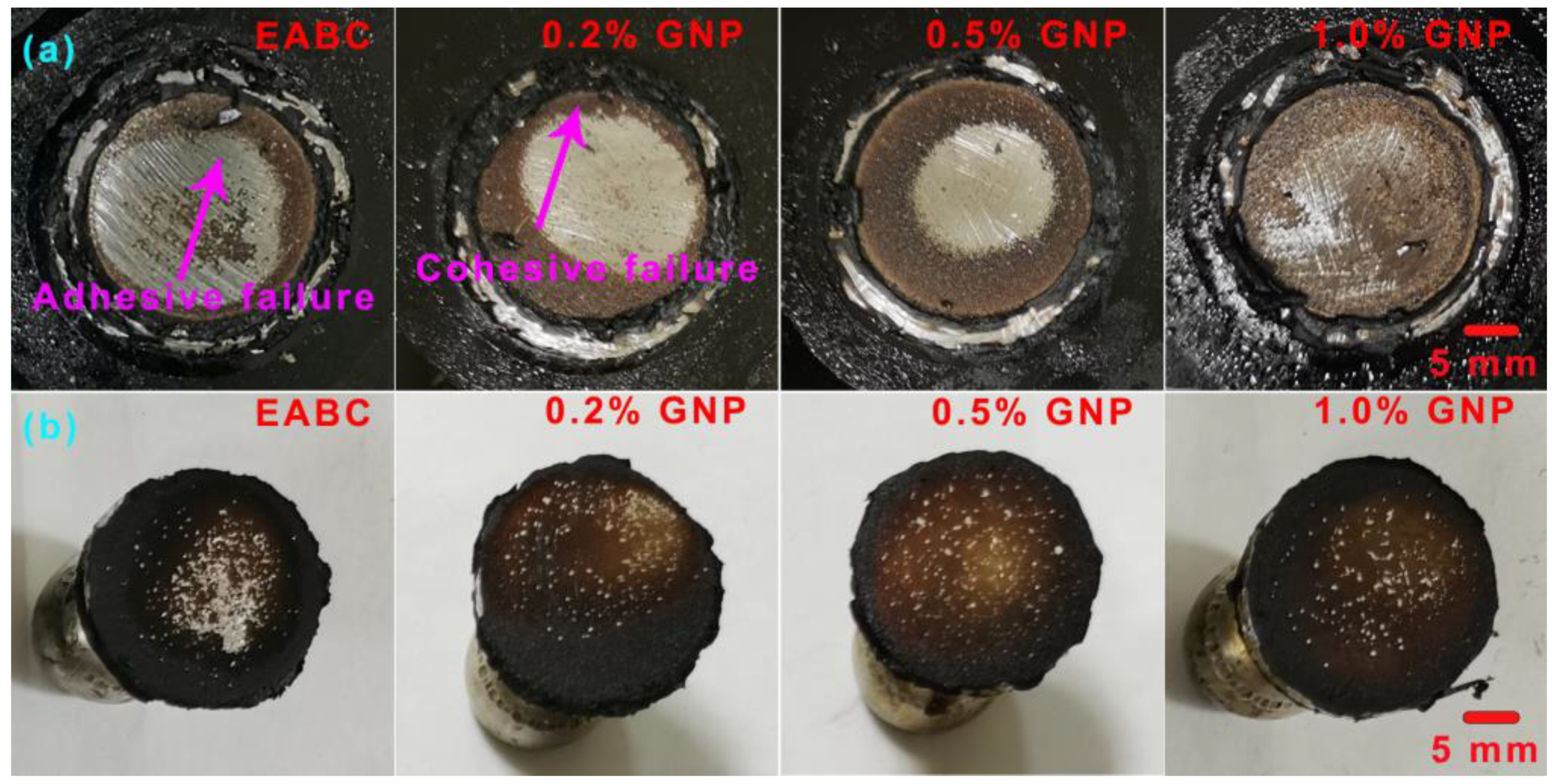
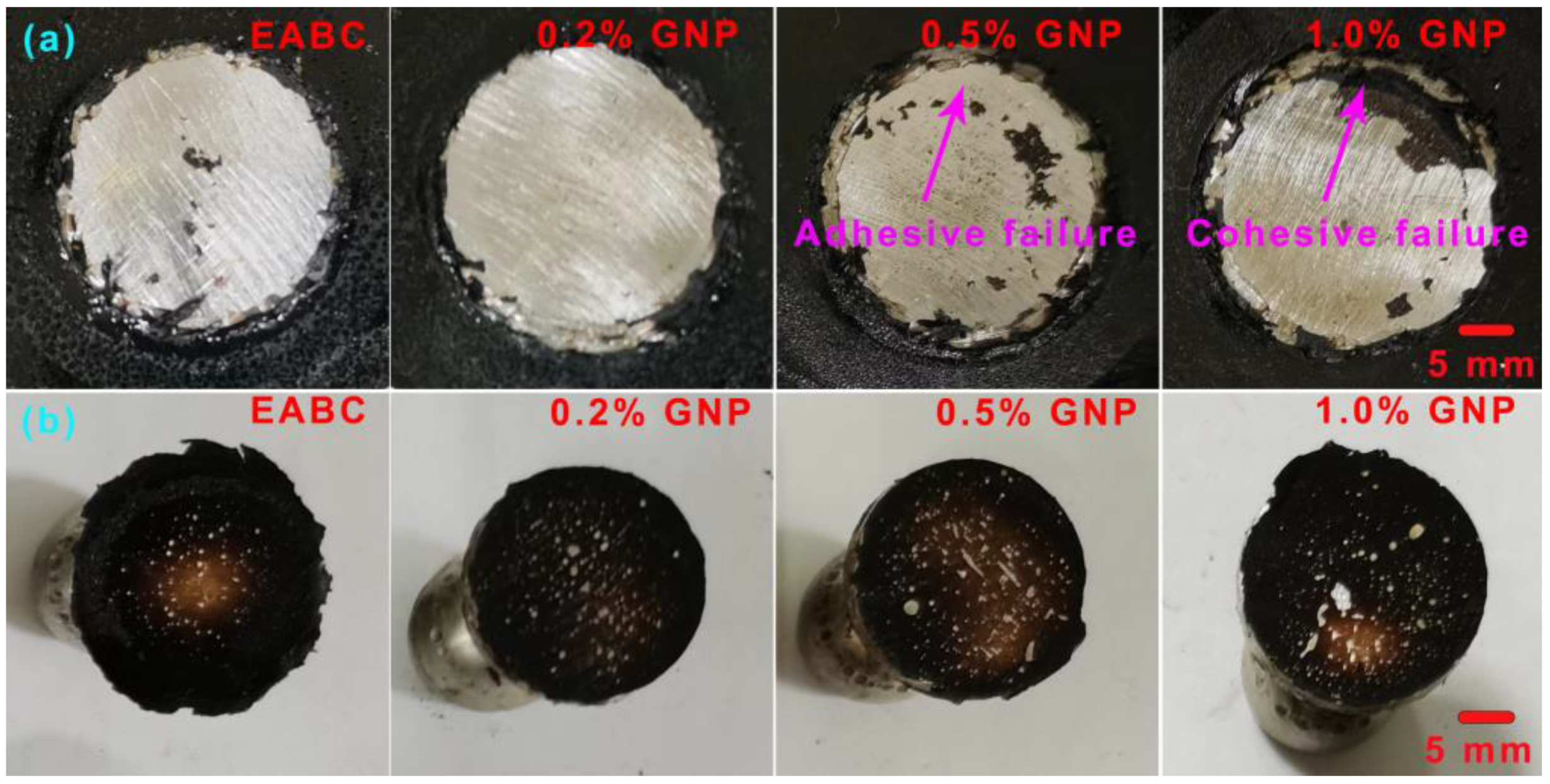
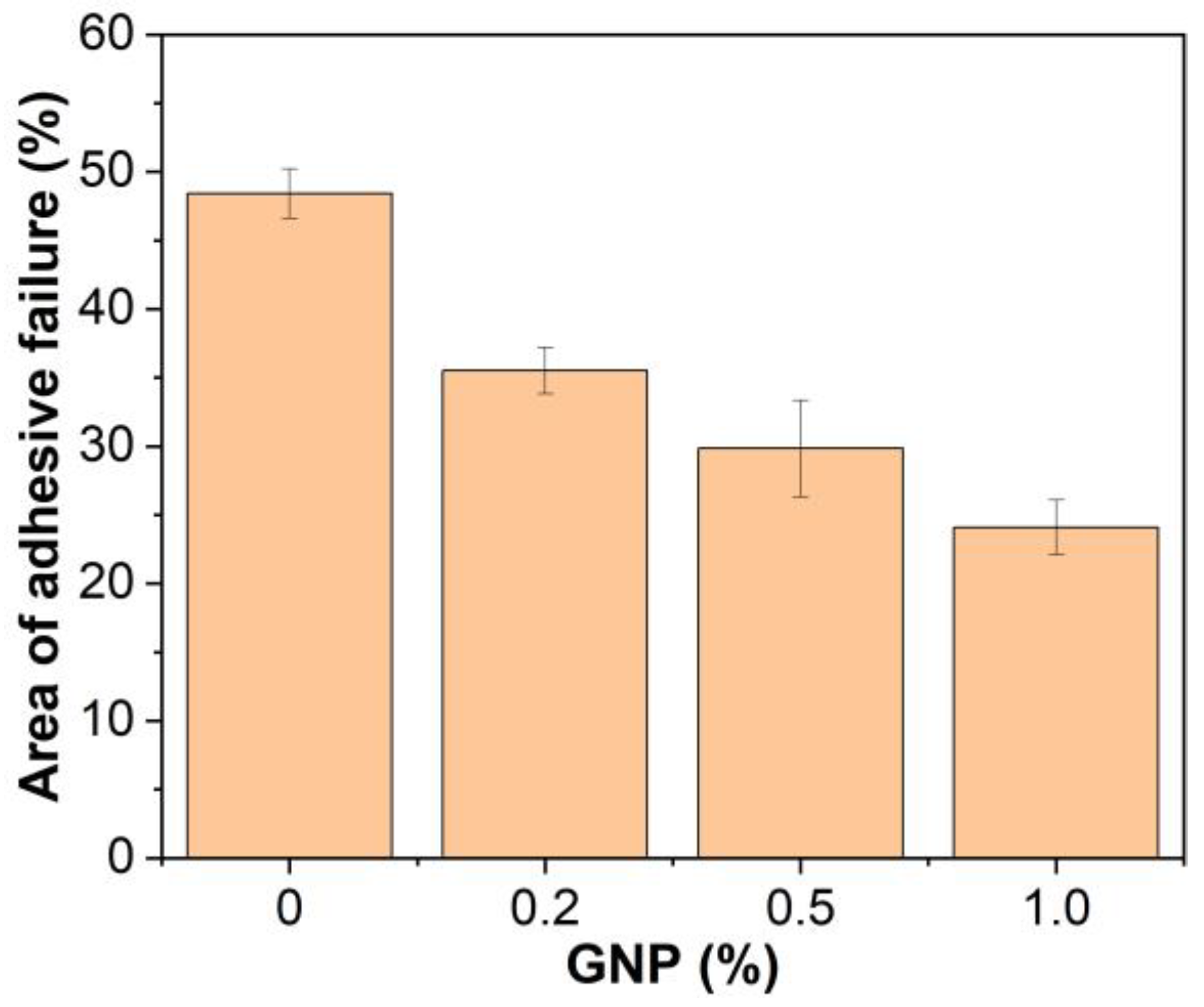
| Property | Value |
|---|---|
| Number of layers | 5~10 |
| Diameter (µm) | 5~50 |
| Thickness (nm) | 3.5~8 |
| Purity (%) | 95 |
| Property | Standard | Value |
|---|---|---|
| Penetration (25 °C, 0.1 mm) | ASTM D5-06 | 91.0 |
| Ductility (10 °C, cm) | ASTM D113-07 | 93.0 |
| Softening point (°C) | ASTM D36-06 | 46.3 |
| Viscosity (120 °C, mPa·s) | ASTM D4402-06 | 787 |
| Saturates (%) | ASTM D4124-09 | 16.7 |
| Aromatics (%) | 33.9 | |
| Resins (%) | 44.7 | |
| Asphaltenes (%) | 4.7 |
| GNP (%) | dn (mm) | dw (mm) | PDI |
|---|---|---|---|
| 0 | 18.6 ± 1.6 | 21.1 ± 1.8 | 1.13 ± 0.01 |
| 0.2 | 21.6 ± 1.7 | 26.2 ± 3.8 | 1.21 ± 0.09 |
| 0.5 | 26.0 ± 6.5 | 32.0 ± 4.7 | 1.27 ± 0.16 |
| 1.0 | 32.4 ± 3.4 | 40.5 ± 5.9 | 1.25 ± 0.04 |
| Nanofiller | Time to 5000 mPa·s (Minute) | Reference | |||
|---|---|---|---|---|---|
| 0 | 0.2% | 0.5% | 1.0% | ||
| GNP | 23 | 25 | 29 | 45 | This work |
| GO | 23 | 25 | 27 | 30 | [35] |
| MMT | 23 | - | - | 26 | [47] |
| ATT | 23 | - | - | 36 | [48] |
| GNP (%) | Tg of Asphalt (°C) | Tg of Epoxy (°C) | CD (mol/m3) | ||
|---|---|---|---|---|---|
| tan δ | E″ | tan δ | E″ | ||
| 0 | −12.9 | −21.3 | 28.1 | 14.5 | 32.8 |
| 0.2 | −9.1 | −18.8 | 27.8 | 12.9 | 33.2 |
| 0.5 | −8.8 | −14.7 | 31.9 | 18.8 | 40.2 |
| 1.0 | −9.3 | −14.3 | 34.4 | 23.3 | 54.7 |
Disclaimer/Publisher’s Note: The statements, opinions and data contained in all publications are solely those of the individual author(s) and contributor(s) and not of MDPI and/or the editor(s). MDPI and/or the editor(s) disclaim responsibility for any injury to people or property resulting from any ideas, methods, instructions or products referred to in the content. |
© 2023 by the authors. Licensee MDPI, Basel, Switzerland. This article is an open access article distributed under the terms and conditions of the Creative Commons Attribution (CC BY) license (https://creativecommons.org/licenses/by/4.0/).
Share and Cite
Jing, F.; Wang, R.; Zhao, R.; Li, C.; Cai, J.; Ding, G.; Wang, Q.; Xie, H. Enhancement of Bonding and Mechanical Performance of Epoxy Asphalt Bond Coats with Graphene Nanoplatelets. Polymers 2023, 15, 412. https://doi.org/10.3390/polym15020412
Jing F, Wang R, Zhao R, Li C, Cai J, Ding G, Wang Q, Xie H. Enhancement of Bonding and Mechanical Performance of Epoxy Asphalt Bond Coats with Graphene Nanoplatelets. Polymers. 2023; 15(2):412. https://doi.org/10.3390/polym15020412
Chicago/Turabian StyleJing, Fan, Rui Wang, Ruikang Zhao, Chenxuan Li, Jun Cai, Guowei Ding, Qingjun Wang, and Hongfeng Xie. 2023. "Enhancement of Bonding and Mechanical Performance of Epoxy Asphalt Bond Coats with Graphene Nanoplatelets" Polymers 15, no. 2: 412. https://doi.org/10.3390/polym15020412





